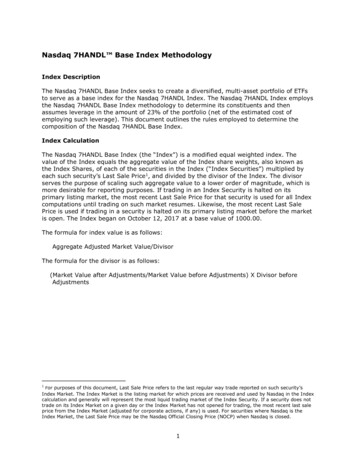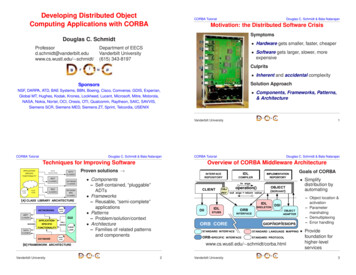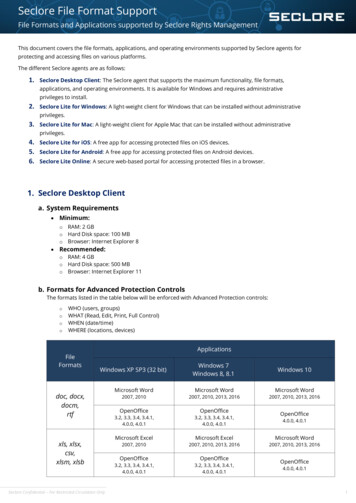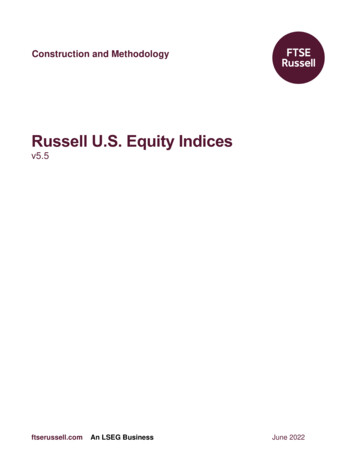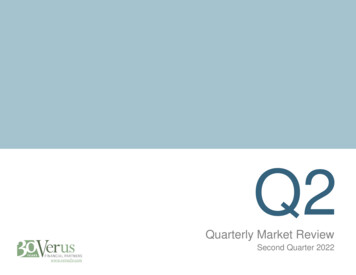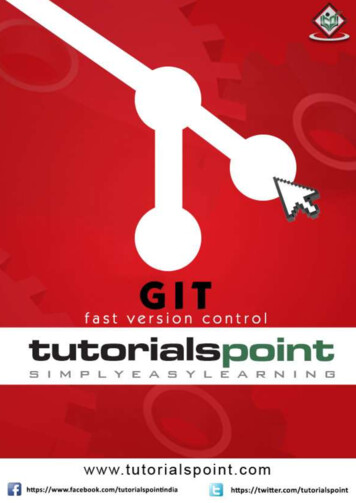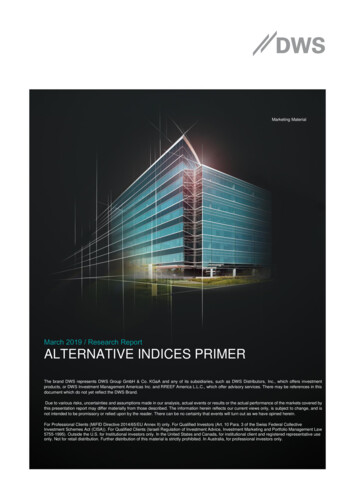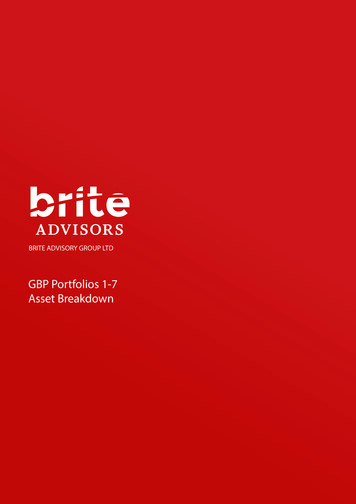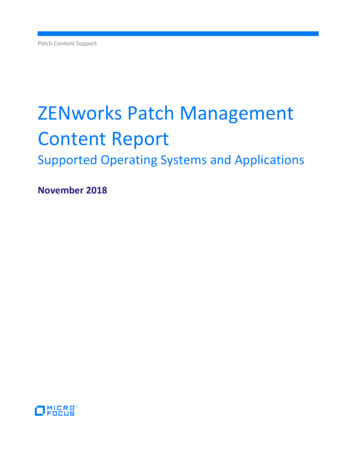![INDEX [bdtmaterial.blob.core.windows ]](/img/30/1-architecting-and-implementing.jpg)
Transcription
Architecting and Implementing Modern Cloud Native and Microservices Based ApplicationINDEXWhat is Cloud-Native. 1Why one should learn Microservices . 1Our Training Methodology . 1Who can do this course? . 2What you will get . 2Course Objectives . 2Syllabus . 4WHAT IS CLOUD-NATIVECloud native is a lot more than just signing up with a cloud provider and using it to run your existingapplications. It affects the design, implementation, deployment, and operation of your application.It is an approach to building and running applications that fully exploit the advantages of the cloudcomputing model.WHY ONE SHOULD LEARN MICROSERVICES?We have noticed that technologies today have evolved a lot to suit the requirements of today'sneeds of customers and projects.If you are a hardcore developer in Microsoft stack and not using the latest features of thetechnology especially .NET Core very soon you will find yourself outdated.Building a Microservices application will give you an opportunity to touch base with all the advancedfeatures of the language and expand your scope.OUR TRAINING METHODOLOGYIn this course we will start with a basic CRUD microservice and then progressively develop the sameproject and add new features with more and more microservices. This will give the audience the feelof working with a live project as in real-time development scenarios. The same is reflected in oursyllabus in the form an eStoreApplication at the end of each module.Our star trainer Mr. Sandeep Soni having 23 years of experience in IT industry has compiled thiscourse and he will be himself delivering it.1
Architecting and Implementing Modern Cloud Native and Microservices Based ApplicationThe teaching methodology of Mr. Sandeep Soni, is very simple but comprehensive, every topicbegins with in-depth concepts of Microservices Architecture, to position the candidate in acomfortable state about what is being talked about, followed by that practical demos as in real-timeon every topic is taken explaining how the feature can be incorporated in real-time situations.You will be given enough subject knowledge for you to feel that you have additional 2 to 4 years ofexperience in technology.WHO CAN DO THIS COURSE?1. Any MS.NET developer with knowledge of .NET and C# can take this.2. Architects looking forward to build Microservices based applications.WHAT WILL YOU GET? (SPECIAL OFFER for this batch only!) Exhaustive training by Microsoft Certified Trainer, Mr. Sandeep Soni having 2 years ofexperience. You will get video access to the recorded sessions of the live training. You will get in-detailed and Complete Courseware prepared by Mr. Sandeep Soni himself andsame can be used as for practice and reference. ONE YEAR validity – You can repeat this course three times a year. You can attend Microservices Full-day Bootcamps in future.COURSE OBJECTIVESUnderstanding Microservices Architecture for building Enterprise ApplicationsBuilding and consuming Restful MicroservicesBuilding Multi-Layer Architecture within a MicroserviceUsing Swagger for Testing MicroservicesImplementing Repository PatternDeploying multiple microservices using Docker and YAMLImplementing Security in Microservices using OAuth and OpenIDConnectImplementing API Gateway for Microservices using OcelotAsynchronous Communication between Microservices using Azure Service BusUnderstanding and Implementation of CQRS PatternUnderstanding and Implementing Domain Driven DesignImplementing Circuit Breaker Pattern using Poly.Deploying Microservices using a CI and CD pipeline in Azure DevOps2
Architecting and Implementing Modern Cloud Native and Microservices Based ApplicationUnderstanding how Kubernetes Orchestration can be used for hosting MicroservicesSYLLABUSArchitecting and Building MicroservicesUnderstanding Microservices Understanding Monolithic ArchitectureoWhat are Monolithic ApplicationsoDeployingoContainerizing using DockeroScaling ApplicationsoManaging State and DataoBenefits and Drawbacks of Monolithic ArchitectureMicroservices ArchitectureoWhat are MicroservicesoMonolithic vs Microservices ArchitectureoCharacteristics of Microservices ArchitectureoBenefits of using Microservices ArchitectureoMicroservices Design Principles. SOA vs. Microservice Handling Data in Microservices Communication between MicroservicesoSynchronous Communication across Microservices.oAsynchronous communication across Microservices. API Gateway Pattern Microservices PatternsoDomain Driven DesignoCommand and Query Responsibility Separation (CQRS)oEvent Sourcing Creating Composite UI with Microservices Drawbacks of MicroservicesSetup Microservice Based Application and Perform CRUD Operations Creating a Solution and Project Layout Implementing a CRUD microservice Writing Domain Classes and Controllers Data Context Class and Data Seeding Using Repository Classes3
Architecting and Implementing Modern Cloud Native and Microservices Based Application Swagger and SwashBuckle Integration Practical Demonstration using eStoreApplication Product CatalogService with SQL Server Invoking both services using Swagger UI Implementing Layered Architecture Generic Repository PatternAzure Services Covered: Azure App Service SQL Database Programming Storage AccountBuild UI Service Adding ASP.NET MVC Project Writing Model Classes Writing Service Classes Building Web Controller and Views Practical Demonstration using eStoreApplicationa.Writing Backend for Frontend (BFF)b.UI Microservice to display Product CatalogHosting Microservices using Docker Containers Adding Docker Support to the Microservice Application Creating a Dockerfile file Designing and Developing Multi-Container Microservices Database Connection string and environment variables in Docker containers Handling Configuration Data Practical Demonstration using eStoreApplication oCreate a docker images for Product Catalog MicroservicesoCreate a docker image for UI MicroserviceoWriting a YAML for deploying and executing the application.Azure ServicesoAzure Container RegistryoHosting Multiple Docker Image in App Service using YAMLUsing Redis Cache in Microservices Understanding Redis Cache importance Programming Microservice to use Redis Cache Consuming Microservice in Web Client4
Architecting and Implementing Modern Cloud Native and Microservices Based Application Practical Demonstration using eStoreApplicationoBuilding Shopping Cart MicroserviceoPersisting Cart data in Redis CacheoCreate a docker image for Shopping Cart MicroserviceAzure ServicesoRedis CacheUnderstanding OAuth2 and OpenIdConnect Authentication and Authorization Introduction to Basic Authentication Workflow Understanding OAuth OAuth Grant Types Understanding OpenIDConnect Securing Services and Middleware in ASP.NET Core Using JWT Token to Authenticate and Authorize PracticaloImplementing Basic Authentication using JWT Token and .NET CoreImplementing Security for Microservices The Big Picture Using Client Credential Token to Access Microservice Using Access Token to call Microservices Authentication between Microservices Implementing Role based and Policy based Authorization Practical Demonstration using eStoreApplication oAdding Authentication Microservice to SolutionoSecuring ProductCatalog MicroserviceoAccessing secure ProductCatalog in Client ApplicationAzure ServicesoAzure ADAPI Gateway Integration Introduction to API Gateway Understanding Ocelot Middleware Integrating API Gateway for Routing Handling Secure Microservices in API Gateway Practical Demonstration using eStoreApplicationoAdding API Gateway Service using Azure API Gateway Middleware5
Architecting and Implementing Modern Cloud Native and Microservices Based Applicationo Updating configuration for routing to ProductCatalog and ShoppingCart MicroservicesAzure ServicesoAPI Management (APIM) Setup and Understanding Polcies.Microservices Communication Synchronous Communication using REST API Asynchronous Communication using Service Bus Integration Events and Event Handlers Handing Atomicity and Resiliency when Publishing to EventBus Practical Demonstration using eStoreApplication Adding Product to Shopping Cart Service for logged-in client Create a docker images for Product Catalog Microservices Asynchronous Communicating with Service BusAzure Services Service BusImplementing CQRS Pattern Overview of CRQS Pattern Understanding Command Pattern Domain Model and Read Model Comparing CQRS with traditional CRUD approach Apply CQRS and CQS approach in DDD microservice Practical Demonstration using eStoreApplication a.Build a New ProductCatalog Service Demob.Update ShoppingCart if Product Price changes.c.Update ProductCatalog inventory if order is placed.Azure Servicesa.Azure Service BusDomain Driven Pattern Overview of Domain and Domain Driven Design Layered Architecture in DDD Microservices Implementing the Command and Command Handler Pattern About Domain Events Command and Command Handler Classes Practical Implementation of DDD Pattern Practical Demonstration using eStoreApplication6
Architecting and Implementing Modern Cloud Native and Microservices Based Applicationa.Implementing DDD using Order Microservicesb.Usage of MediateRHandling Failures Handle Partial failure Implement retries and exponential backoff Using Polly policies Circuit Breaker Pattern Practical Demonstration using eStoreApplicationa.Handle Order Service failureb.Handling temporary downtime of SQL Database.WE PROMISE 100% MONEY BACK IF THE STUDENT ATTENDSCOMPLETE COURSE AND IS NOT SATISFIED WITH THE QUALITY services-online-training7
Building a Microservices application will give you an opportunity to touch base with all the advanced features of the language and expand your scope. OUR TRAINING METHODOLOGY In this course we will start with a basic CRUD microservice and then progressively develop the same

